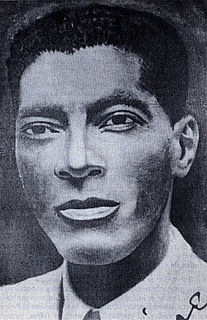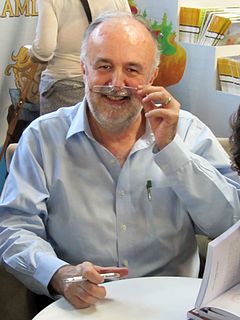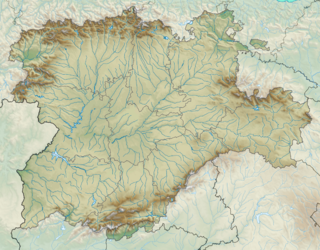Related Research Articles

Trujillo is a city in coastal northwestern Peru and the capital of the Department of La Libertad. It is the third most populous city and center of the third most populous metropolitan area of Peru. It is located on the banks of the Moche River, near its mouth at the Pacific Ocean, in the Moche Valley. This was a site of the great prehistoric Moche and Chimu cultures before the Inca conquest and subsequent expansion.

Dulce María Loynaz Muñoz was a Cuban poet.

Hornazo is a Spanish meat pie eaten in the provinces of Salamanca and Ávila. It is made with flour and yeast and stuffed with pork loin, spicy chorizo, and hard-boiled eggs.

Carmen Martín Gaite was a Spanish author. She wrote in many genres, including novels, short stories, and essays. She also wrote screenplays. Over the course of her life, she won various awards, including the Premio Nadal in 1957 for Entre visillos, the Prince of Asturias Awards in 1988, the Award Premio Castilla y León de las Letras in 1992, and the Premio Acebo de Honor awarded to her life work.

Colonia Roma, also called La Roma or simply, Roma, is a district located in the Cuauhtémoc borough of Mexico City just west of the city's historic center, and in fact is no longer a single colonia (neighbourhood) but now two officially defined ones, Roma Norte and Roma Sur, divided by Coahuila street.
Mariachi los Camperos de Nati Cano is a Grammy Award-winning Los Angeles-based mariachi ensemble which was formerly led by Natividad "Nati" Cano.

Miguel Ángel Solá is a prolific Argentine actor who has made over 60 film appearances in film and TV in Argentina since 1973.

Prostitution in Spain is not addressed by any specific law, but a number of activities related to it, such as pimping, are illegal. In 2016, UNAIDS estimated there to be 70,268 prostitutes in the country, although other estimates put the number in the 300,000 - 400,000 region. The sex industry in Spain is estimated to be worth €3.7 billion.

Manuel Corona Raimundo was a Cuban trova musician, and a long-term professional rival of Sindo Garay.

The Whore and the Whale is a 2004 Hispano-Argentine drama film directed by Luis Puenzo. The film tells the interwoven stories of a Spanish writer whose life goes through various crises and an Argentine photographer who rescued a prostitute from a brothel in the far south of Patagonia but lost her and then died in the Spanish Civil War.

Holy Week in Spain is the annual tribute of the Passion of Jesus Christ celebrated by Catholic religious brotherhoods and fraternities that perform penance processions on the streets of almost every Spanish city and town during the last week of Lent, the week immediately before Easter.

Pelayos de la Presa is a municipality in the Community of Madrid, Spain. It covers an area of 7.58 km2. As of 2018, it has a population of 2,475.

Salamanca is a city situated in western Spain and is the capital of the Province of Salamanca in the autonomous community of Castile and León. The city lies on several rolling hills by the Tormes River. Its Old City was declared a UNESCO World Heritage Site in 1988. As of 2018, the municipality has a population of 143,978.

María Zahara Gordillo Campos, better known as Zahara, is a Spanish singer-songwriter.

Holy Week in Salamanca is the most important religious event of Salamanca, Spain. It is celebrated in the week leading up to Easter.

The Illustrious Brotherhood of the Holy Cross of the Redeemer and the Immaculate Conception, his Mother, known as the Vera Cruz or True Cross is a Catholic fraternity established in Salamanca, Castile and León, Spain in 1506.

Marco Antonio de la Parra is a Chilean psychiatrist, writer, and dramatist. Many of his works, which are strongly influenced by the country's 1973–90 military regime, satirize the national condition through metaphors. He is the author of more than 70 titles translated into several languages, including plays, novels, storybooks, and essays.
Carla Berrocal is a Spanish comics illustrator. She is the president of the Professional Association of Illustrators of Madrid and one of the promoters of the Comic Authors' Collective.

The Barrio Chino de Salamanca was the area of the city of Salamanca, Spain, where brothels and similar establishments were located. Throughout its long history, its location has gradually moved from the banks of the Tormes river to the area known as Vaguada de la Palma.

Rafael Antonio Salazar Motos, commonly known as Rafael Farina, was a singer of Copla and Flamenco. His granddaughter is the pop-singer Tamara.
References
- 1 2 "Origen de la tradición del 'Padre Putas'" [Origin of the 'Padre Putas' tradition]. NoticiasCYL (in Spanish). 10 April 2018. Retrieved 13 April 2020.
- ↑ Ray 2013, p. 133.
- 1 2 Montero, José Ángel (19 August 2019). "Ruta por la Salamanca más erótica y pícara" [Route through the most erotic and mischievous Salamanca]. www.lagacetadesalamanca.es (in Spanish). Retrieved 12 April 2020.
- ↑ Guereña 2003, pp. 130-136.
- ↑ Gómez 1986, pp. 93,127.
- ↑ "Semana Santa insólita - Salamanca, el "padre putas" y el Lunes de Aguas" [Unusual Easter - Salamanca, the "father whores" and the Monday of Waters]. gozARTE (in Spanish). 28 February 2012. Retrieved 9 April 2020.
- 1 2 Gratchev & Mancing 2018, pp. 120-121.
- ↑ "La tradición y el 'Padre Putas'" [Tradition and the 'Padre Putas']. www.lagacetadesalamanca.es (in Spanish). 13 April 2015.
- ↑ "Cuelgan varios muñecos ahorcados y pancartas contra el Lunes de Aguas y el "proxeneta" Padre Putas" [Several hanged dolls and banners hang against the Monday of Waters and the "pimp" Padre Putas]. El Norte de Castilla (in Spanish). 29 April 2019. Retrieved 13 April 2020.
- ↑ "El Padre Putas in Salamanca - Restaurant reviews". Restaurant Guru. Retrieved 13 April 2020.